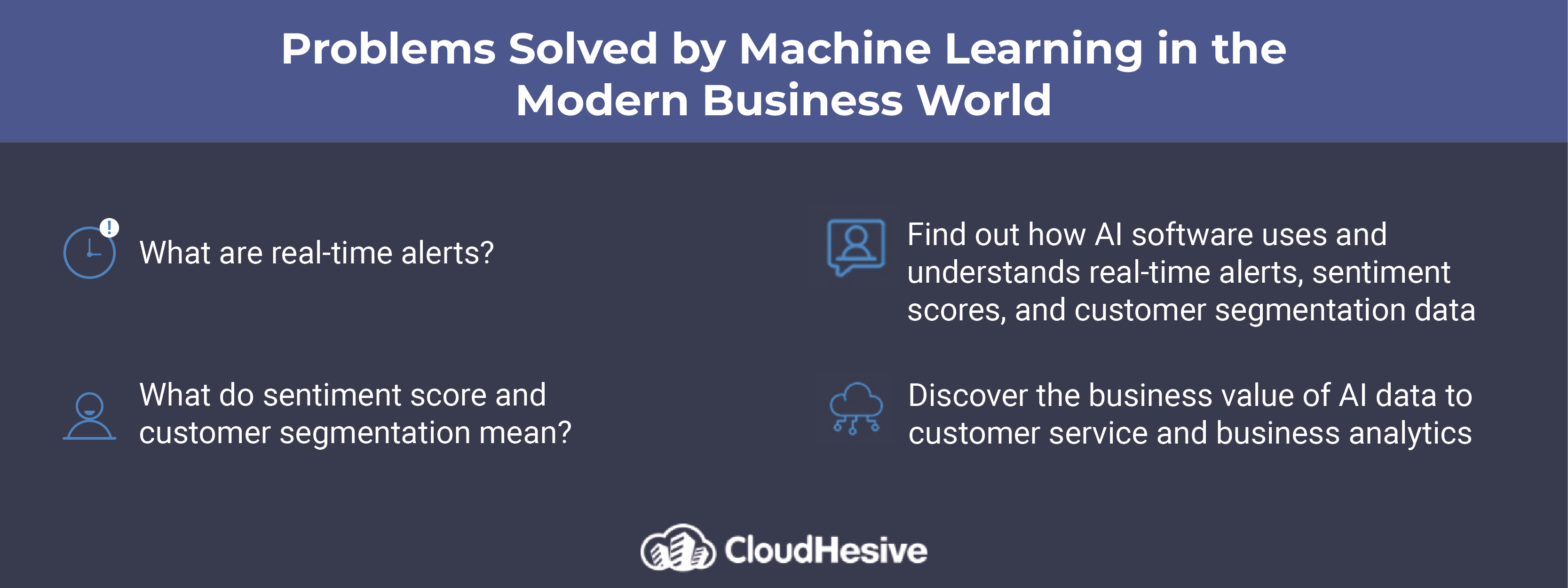Customer service problems solved by machine learning

Machine learning takes a business’s customer data and analyzes it into patterns for finding solutions. Computer-coded algorithms learn the data and create business analytics that can be used to predict future needs and outcomes. Using machine learning capabilities improves customer service productivity and quality by replacing manual processes and promotes consistency by using real customer data.
Customer data analysis is key to focusing marketing efforts on groups of customers, receiving real-time alerts for issues, and personalizing customer service to both attract new customers and retain existing ones.
Machine learning technology for customer service is part of what’s called the fourth major industrial revolution. Automated customer service features represent a fusion of technologies that combine to separate the physical, digital, and biological worlds and combine data into useful patterns businesses can use for customer retention and business growth.
ML technology enables businesses to effectively leverage their customer data to precisely target marketing and customer service efforts. Businesses use ML technology to acquire new customers and retain them with consistent, accurate, and personalized customer service.
This guide provides information on the business problems solved by machine learning to grow a successful business using analytics based on real data.
Provide your team with real-time alert capabilities
Real-time alerts are notifications automatically generated and sent to personnel to alert them of an issue. For example, a real-time alert generates to a customer service manager when the system determines that a customer service call does not meet company standards. In Contact Lens, real-time customer service alerts are customizable to fit the business need.
Real-time alerts for a computer system may also indicate a security issue or attempted security breach. Additionally, a real-time alert may be triggered when a product a customer has ordered is out of stock or behind the indicated shipping schedule. Real-time alerts serve to enhance the customer experience by alerting designated users to a business issue.
Without machine learning analyzing the data, real-time alerts aren’t possible. Alerts may happen, but typically only after the issue has occurred instead of beforehand or while the issue is in progress.
Sentiment score and customer segmentation
Sentiment analysis or scoring analyzes the voice of a speaker and determines the emotion behind the words. In sentiment analysis, ML algorithms analyze data to understand the emotion behind a human conversation.
By reviewing recorded transcripts of customer service calls, issues or corrections are made after the fact. With ML, the computer system understands the emotion behind the words and discerns when a customer says they’re satisfied but in reality are not. Perhaps the customer simply wants off the call, or perhaps they’re so annoyed they can’t deal with the customer service agent any longer in a positive manner. Sentiment scores enable customer service agents or marketing professionals to understand what the customer is feeling but not expressing.
For example, AWS Contact Lens is an example of one machine learning tool that analyzes the sentiment of every speaker during a conversation. The frequency and proximity of the sentiment are scored for each portion of the call, and then an average score gets assigned to the call record on call completion. Customer service managers use the scores to better train agents to manage customers throughout the call to positively impact the customer experience.
Customer segmentation means taking customers and grouping them based on their interests. Customer segmentation allows sales and marketing efforts to be targeted to customers who are interested in the product or service. Data segmentation allows the personalization of advertising, sales, and special promotions based on a customer’s purchase history or usage data. Targeted marketing means ads are focused on specific customer groups rather than sent out to everyone.
Typical customer segmentation includes groups based on the following factors:
- Age
- Gender
- Education level
- Income
- Products used
- Services used
- Geographic location
- Behavioral patterns
- Lifestyle and activities
ML technology allows for multiple grouping combinations of customer data for more focused marketing, customer service, or business response. The more accurate the customer grouping, the more successful the response.
Voice-ID
Amazon Connect Voice ID, a feature of Amazon Connect, uses machine learning to provide real-time caller authentication and fraud risk detection to make voice interactions faster and more secure.
No longer due contact centers have to deploy complex authentication tools and processes to ensure the identity of remote agents. Amazon Connect Voice ID analyzes the voice characteristics of an agent or caller to provide self-service interactive voice response (IVR) systems with a real-time decision on caller’s identity to ensure the authenticity of the agent. Amazon Connect Voice ID also screens for fraudulent actors in real-time, based on your contact center’s custom watchlist, reducing potential losses from fraudulent attacks.
Business value of ML data analysis
What is the business value of data analytics based on customer contact? Customer contact data from any channel (phone, text, SMS, chat, or other) provides the data a business needs to make better decisions and improve short- and long-term profitability. Customer data analysis provides the knowledge to sustain a competitive advantage by attracting new customers and retaining existing ones. Organizations using ML capabilities of customer data analysis respond to market conditions faster while achieving higher levels of customer satisfaction.
Business organizations must leverage customer data to improve the customer experience. Positive customer experiences create a competitive business advantage regardless of the industry. By personalizing customer experiences while keeping the human interaction element intact, companies are taking advantage of solutions using ML to improve their overall customer experience.
AWS provides machine learning capabilities that are integrated into multiple tools. These capabilities enable businesses to create data analytics from actual customer-call recordings or utilize live tracking for analyzing customer sentiment and trends and creating customer segmentation groups. Using real customer data through ML improves the accuracy of data analytics specific to a business’s customer base.
Businesses benefit by providing faster, personalized, and more responsive customer service. CloudHesive understands the specific features available in the AWS family of ML-enhanced tools and how to implement them to take your team to the next level.
CloudHesive provides assistance and knowledge on using the AWS cloud. As an Amazon Managed Services Partner and Amazon Premier Partner, CloudHesive helps businesses take advantage of all the features AWS offers. Check out case studies from AWS Contact Lens success stories, and see if using CloudHesive and AWS Contact Lens can benefit your business.



